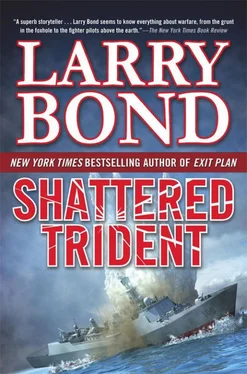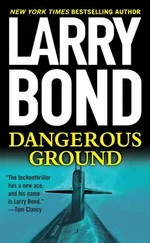Before Jerry could ask for any details, a warning alarm suddenly sounded in control.
“Conn, ESM. Have an APS-504 radar, signal strength three, bearing zero one three, closing fast.”
Sobecki didn’t acknowledge the report right away; he had to move quickly, as a Chinese Y-8 maritime patrol aircraft was getting dangerously close. The aircraft’s surface search radar was a significant detection threat to the two exposed masts.
“Lower all masts!” he cried.
The optics mast operator and copilot echoed the command as they manipulated their controls, dipping the masts below the ocean’s surface. Jerry could feel the tension rising in the air. The watchstanders had acted properly, but they were all on edge.
“Sorry, Skipper, it’s been hectic,” apologized Sobecki. “A lot of search-and-rescue traffic popped up in the last fifteen minutes. That was our second Y-8 MPA, probably one of their alert aircraft.”
“You’re doing fine, Phil,” Jerry reassured his third in command. “Now, tell me what’s going on.”
Sobecki wasn’t able to utter a word before Thigpen interrupted him, “Here you go, Skipper. This is the Reader’s Digest version of the story; if you’re happy with this we can send it out as soon as the airspace clears.”
Jerry took the hard-copy message from his XO and quickly scanned it. He skipped through the preamble after making sure the “Z” prosign for “Flash” precedence was present. Jerry was less interested in proper format right now than he was in the content.
Jumping to the body of the message, he noted the location of the first set of explosions—latitude 17° 54’ N, longitude 108° 46’ E—almost forty-nine nautical miles to the west; the time, 0159 local; and the tactical assessment. His eyes quickly homed in on the sentence: “ISR UUV acoustic data showed two TE-2 torpedoes fired by probable Vietnamese Kilo-class submarine at a Chinese merchant, subsequently identified as the China Ocean Shipping Company tanker Yan Shui Hu, 25,428 gross registered tons.”
Jerry shook his head as he continued reading. The information content of the message was good; its implications were anything but. He moved on to the second set of explosions, which had far less data. However, the conclusion that it was possibly due to another submarine attack made it just as stark. Grunting his approval, he handed the draft back to Thigpen.
“Send it, XO.”
“Yes, sir,” replied Thigpen, visibly relieved. As he headed back to the radio room, Jerry called back to him.
“XO. Nice work, Bernie.”
* * *
Ten minutes later, with North Dakota back down to 150 feet, the atmosphere in control began to ease. Jerry hovered over the spare common console as LT Covey walked him through the engagement. The Kilo had positioned itself off the starboard beam of the tanker and fired a two-weapon salvo at a range of 4,500 yards. It was a textbook Russian attack, deliberate and premeditated; there was no other way to describe it.
While Jerry, Thigpen, and Sobecki dissected the Kilo’s tactics, one of the electronics technicians poked his head out of the ESM bay. “Skipper, XO. We picked up something you’ll be interested in.”
Jerry and Thigpen crammed themselves into the tight ESM shack, while Sobecki leaned in from the doorway. “What goodies did you vacuum from the ether, Petty Officer Fleming?” asked Thigpen with a lighthearted tone.
Fleming smiled as he pointed toward a young third class. “Petty Officer Kalinsky here has been going over the material we collected while we were uploading the message, and he found some pretty interesting stuff. Go ahead and tell the skipper, Gus.”
Kalinsky was one of the CT riders, a cryptologic technician attached to North Dakota in support of the special operations mission. Linguistic experts are often added to a submarine’s crew to provide on-the-spot information by monitoring the local radio frequencies. Many an intelligence gem had been harvested in the past by the careless transmission of someone who thought they wouldn’t be heard.
“Yes, sir, Captain,” stammered the young sailor. “While the boat transmitted the message, I picked up a lot of voice traffic from the port authority at Yulin. Most of the chatter was from rescue ships asking where they needed to go to assist. Well, one of those rescue ships was heading in the direction of the second set of explosions, and that dude was really confused. The guy at the port authority started shouting at the captain and repeated the location and identification data for another ship. I wrote it down as quickly as I could. Here it is, along with a rough translation.”
Jerry took the sheet of torn paper and looked at the hastily written notes. The top lines contained Chinese characters. Sloppily written, they looked like a child’s chicken scratches. Below them, however, were neatly printed English words—their meaning electrifying. Jerry read them out loud.
“Distress beacon transmission, merchant vessel Chang Chi, lat 17° 25’N, long 111° 10’ E. No response to radio hails.” Jerry handed the notes to Thigpen. “Eng, look up the Chang Chi .”
“Already did that, sir,” Fleming exclaimed. “It’s another tanker, Skipper. Motor vessel Chang Chi, crude oil tanker, 27,155 gross registered tons, owned and operated by the Nanjing Tanker Company.” Fleming handed the report chit to his CO.
“Well done, Petty Officer Fleming. You too, Petty Officer Kalinsky. That was mighty fine detective work.” Jerry was pleased with his people’s performance. He briefly looked again at the Chang Chi ’s information, and a frown formed on his face.
“Two tankers. Just a coincidence, or an indication?” Jerry asked openly.
Thigpen chuckled. “Just a coincidence, Skipper? An ice cube has a better chance in a blast furnace. These were deliberate attacks. In my opinion, it’s an indication.” Then, deftly snatching the report chit from Jerry’s hand, Thigpen added, “Well, it looks like I have another message to write.”
“I believe you do, too,” agreed Jerry.
30 August 2016
2100 Local Time
USS North Dakota
Off Hainan Island, South China Sea
Jerry paced back and forth in his stateroom. There hadn’t been any response from squadron on his two messages, nothing. There were snippets of information in the routine broadcasts that hinted at possible attacks elsewhere along the Chinese coast, but nothing with any substance, no details. Adding to his frustration, Fargo had lost contact with the Kilo. Whoever the captain was, he knew his business. He craftily merged with a small fishing fleet before he started snorkeling. The UUV’s autonomous detection algorithms couldn’t differentiate one marine diesel from another, and dutifully locked on to the loudest source around the Kilo’s last known bearing—a large fishing boat. The sonar techs had plowed through the last data dump and were confident the UUV had been tracking the fishing vessel for at least an hour.
* * *
“I don’t want to let this guy go,” he had said earlier to his XO and department heads. “He’s a known bad actor, and I’ve got a nagging feeling we’ve only seen the beginning.”
“But Skipper, why couldn’t these two attacks just be a tit-for-tat retaliation for the 093’s sinking of the Vinaship Sea ?” asked Rothwell.
“That’s a possibility, Nav, but the dots don’t stack up very well for that hypothesis,” Thigpen argued, referring to the fire control’s visual display of a neat vertical line of bearing dots when the solution was a good one. “This would be the second rotation on the retaliation merry-go-round. Remember, the Vietnamese mined the carrier first. I doubt the Chinese will let these attacks go unanswered.”
Читать дальше

![Никки Сикс - Героиновые дневники. Год из жизни павшей рок-звезды[The Heroin Diaries - A Year in the Life of a Shattered Rock Star]](/books/78612/nikki-siks-geroinovye-dnevniki-god-iz-zhizni-pavshej-rok-zvezdy-the-heroin-diaries-a-yea-thumb.webp)










